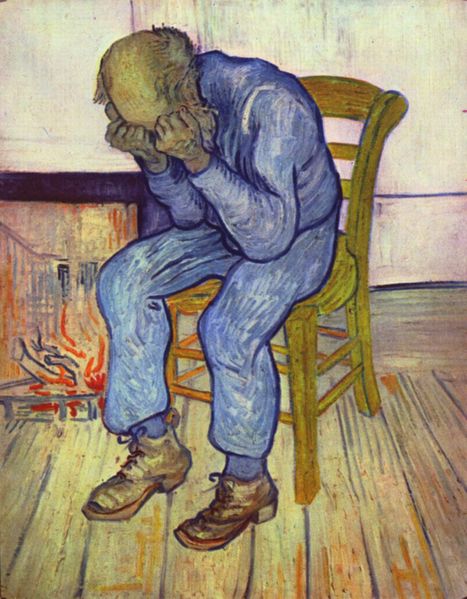Clinical depression overview: Difference between revisions
No edit summary |
No edit summary |
||
| Line 5: | Line 5: | ||
==Overview== | ==Overview== | ||
[[Image:Vincent Willem van Gogh 002.jpg|thumb|200px|''On the Threshold of Eternity''. In 1890, [[Vincent van Gogh]] painted this picture seen by some as symbolizing the despair and hopelessness felt in depression. Van Gogh himself suffered from depression and committed [[suicide]] later that same year.]] | [[Image:Vincent Willem van Gogh 002.jpg|thumb|200px|''On the Threshold of Eternity''. In 1890, [[Vincent van Gogh]] painted this picture seen by some as symbolizing the despair and hopelessness felt in depression. Van Gogh himself suffered from depression and committed [[suicide]] later that same year.]] | ||
Clinical depression is a [[psychiatric disorder]], characterized by a pervasive low mood, loss of interest in usual activities and diminished ability to experience pleasure. | |||
Although the term "depression" is commonly used to describe a temporary [[depression (mood)|depressed mood]] when one "feels blue", clinical depression is a serious and often disabling condition that can significantly affect a person's work, family and school life, sleeping and eating habits, general health and ability to enjoy life.<ref name="NIMHPub">{{cite web | Although the term "depression" is commonly used to describe a temporary [[depression (mood)|depressed mood]] when one "feels blue", clinical depression is a serious and often disabling condition that can significantly affect a person's work, family and school life, sleeping and eating habits, general health and ability to enjoy life.<ref name="NIMHPub">{{cite web | ||
Revision as of 21:48, 2 February 2013
|
Clinical Depression Microchapters |
|
Diagnosis |
|---|
|
Treatment |
|
Follow-up |
|
Case Studies |
|
Clinical depression overview On the Web |
|
American Roentgen Ray Society Images of Clinical depression overview |
|
Risk calculators and risk factors for Clinical depression overview |
Editor-In-Chief: C. Michael Gibson, M.S., M.D. [1]
Overview

Clinical depression is a psychiatric disorder, characterized by a pervasive low mood, loss of interest in usual activities and diminished ability to experience pleasure.
Although the term "depression" is commonly used to describe a temporary depressed mood when one "feels blue", clinical depression is a serious and often disabling condition that can significantly affect a person's work, family and school life, sleeping and eating habits, general health and ability to enjoy life.[1] The course of clinical depression varies widely: depression can be a once in a lifetime event or have multiple recurrences, it can appear either gradually or suddenly, and can either last for a few months or be a life-long disorder. Depression is a major risk factor for suicide; in addition, people with depression suffer from higher mortality from other causes.[2]
Clinical depression may be isolated or be a secondary result of a primary condition such as bipolar disorder or chronic pain. When specific treatment is indicated, it usually consists of psychotherapy and antidepressants.
References
- ↑ Mayo Clinic Staff (2006-03-06). "Depression" (PDF). National Institute of Mental Health (NIMH). Retrieved 2007-10-20.
- ↑ Rush AJ (2007). "The varied clinical presentations of major depressive disorder". The Journal of clinical psychiatry. 68 Suppl 8: 4–10. PMID 17640152.